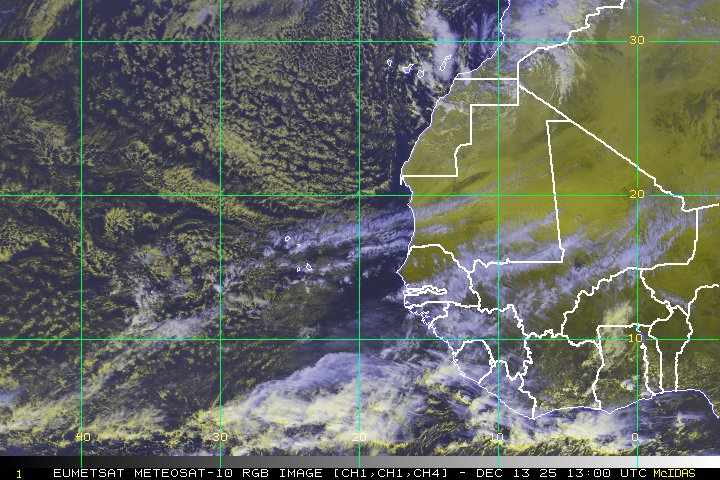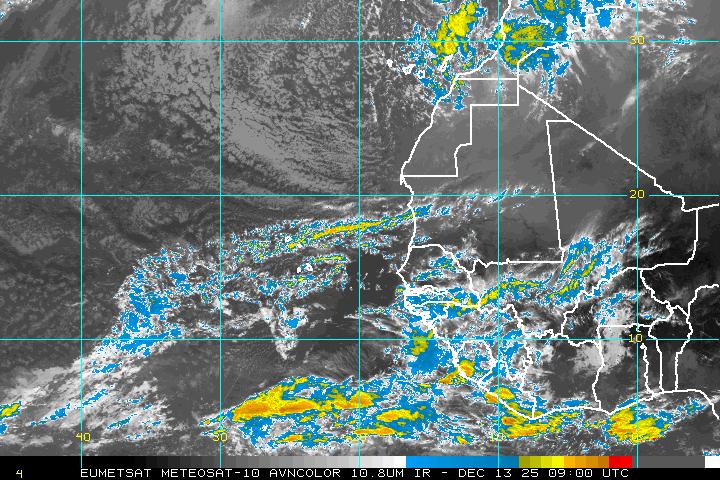
Tropical Activity For August 22nd, 2011
We finally have the first hurricane of the 2011 season! Irene became a hurricane last night and is now traversing between Puerto Rico and Hispaniola with eyes eventually on the Southeast coastline. Harvey has finally dissipated, and 98L continues to be a non-threat for development. Thus, I’ll once again primarily focus on Irene for this discussion.
Hurricane Irene

Visible Loop of Hurricane Irene
Hurricane Irene has continued to move more rightward than expected, and it has now cleared Puerto Rico and is now currently in between Puerto Rico and Hispaniola. Over the last 24 hours, the presentation of the storm has improved, with an eye appearing on microwave imagery, radar imagery, and in recon observations. In addition, recon observations earlier showed that this system continued to track towards the west-northwest at around 290 degrees. More recently, radar observations show that this motion has persisted but slowed a little bit. While visible satellite imagery shows some evidence of dry air on the NW flank of the system, more recently a large blow up of convection near the circulation center shows evidence that this dry air is not being ingested into the core circulation of Irene. However, the close proximity of the circulation to Hispaniola will likely slow or prevent development for the next 18-24 hours. Beyond this time though, a well defined anticyclone continues to persist over Irene, and this along with ample Total Precipitable Water (TPW), and very warm sea surface temperatures exceeding 30 degrees Celsius in spots could lead to rapid development beyond Hispaniola. Beyond this time, the track still remains the big question.

72 hour 500mb heights and Sea Level Pressure From the ECWMF, GFS, GGEM, and UKMET
Plotted above is the 72 hour forecast plots for four of the most widely used global models for tropical cyclone tracking. The most interesting things to note in the early going is that the GFS seems to be the most progressive with the initial east coast trough which allows for a larger weakness initially. The ECWMF still has a bit of ridging that should keep on a slightly more westward track. The GGEM is strange, because it has the same weakness as the GFS, yet does not have as progressive of a trough. Once again I feel that the GGEM may not be handling all the global features correctly and is not considered a very likely solution. On the other side of the spectrum, the UKMET is by far the strongest with the ridging, and this solution is considered a leftward outlier at this time.

96 hour 500mb heights and sea level pressure for the ECWMF, GFS, GGEM, and UKMET
Moving on to day 4, we see that the similar model evolution. The GFS continues to be the most progressive with the first trough, but is also tries to develop a mid-level ridge back over Irene. The ECWMF is the least progressive with the trough, yet it also continues to have a little bit of ridging nosiness north of Irene, keeping it on a slightly west of north track. Its a little strange to see the GFS show more ridging yet have a further eastward track. The GGEM looks like its trying to pick up Irene somewhat from the first trough and this solution is still considered unlikely at this time due to GGEM’s lower verification scores with the weather pattern beyond day 3. UKMET continues to be a western outlier, but has a very similar ridge pattern in comparison to the GFS. My hunch is that while the UKMET is likely too far west, the GFS is also a little bit too far east with Irene.

120 hour 500mb heights and sea level pressure for the ECWMF, GFS, GGEM, and UKMET
Finally we reach the end of my forecast period at 120 hours, when the second trough, the system that expected to pick up Irene, arrives. Due to this late forecast period, the models are literally all over the place with regards to how intense this feature is, although the placement in most of the models doesn’t seem to be as bad. The first think you might note is that the GGEM is well to the NE with Irene from the rest of the global model guidance. This is partially due to the unlikely consequence of the first trough trying to pick up Irene but failing to do so. The solution is strange because the second trough is weaker on the GGEM than any other global model so I’d consider this solution highly suspicious. The GFS is the second furthest east, but this solution makes sense synoptically considering how strong the second trough is depicted in the modeling. Finally, we are left with the ECWMF and the UKMET which both show the system further southwest with a weaker second trough taking longer to pick up Irene.
So great, that’s a lot of analysis of a bunch of model plots, but which one is right. As you probably suspect from my rant above, the GGEM doesn’t seem like a logical solution looking at the upper level pattern in the model. So I’m throwing that model out right from the get go. Thus we are left with the ECWMF, GFS, and the UKMET.
Recently, a NOAA P-3 aircraft is conducting a Gulstream – IV Mission that will sample the atmospheric environment around Irene over the next few hours. The data obtained from this mission will be fed into the next model cycle (00z). However, the data is already available publically now, and we can already infer a few things about the dropsonde data. First of all, dropsonde obs indicate that the mid-level ridge is actually slightly stronger than the GFS model was suggesting at this time earlier today by around 10-20 meters. This might not seem like much, but every little height rise unaccounted for could mean a further west track trend in the modeling when this data is ingested. In addition, the dropsonde soundings closer to the storm show that the 500mb heights were actually a little lower in reality than in the model progs. This might help explain the more poleward motion of the storm than the model guidance was suggesting over the past 24 hours.
So what does this tell us? The lower heights closer to Irene might indicate it will continue on a more northerly path and miss most of Hispaniola. However, if the higher heights hand tough in the Bahamas, this might mean a slightly more westward track in this region. Obviously the atmosphere is very dynamic and we will likely see vast changes occur over the next 24 hours, but the data above suggests that a track closer to the west, perhaps slightly further west than the GFS is more likely. Looking at the overall track guidance, My forecast is that we see Irene take a path just slightly to the left of this envelop, between the EGRI and the TVCN guidance. Intensity wise things have actually become more clear. Now that it seems likely that Irene will miss Hispaniola, there is little to nothing impeding the future intensity of Irene. A significant portion of the model guidance takes Irene to major hurricane status between 60 and 72 hours, and I’d be inclined to agree.

Third Forecast Map For Tropical Storm Irene
EDIT: Irene is now a Category 2 hurricane with 100mph winds. This forced me to make a last minute edit about the first 48 hour forecast which is now significantly higher. Between 24 and 72 hours Irene will likely undergo rapid intensification under very favorable conditions. Beyond this period, sea surface temperatures drop slightly and the chances of an eyewall replacement cycle (EWRC) increase. Thus I have the winds slowly decreasing to 135mph by landfall. This is still a very formidable category 4 hurricane. The track is a blend of The ECWMF and UKMET with more emphasis on the ECWMF. Stay tuned to your local weather affiliate and this blog for updates, as this storms looks like it will be the real deal. I should have an update around this time tomorrow unless there are major changes beforehand.




















